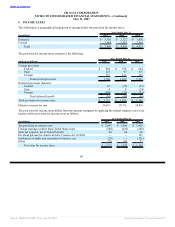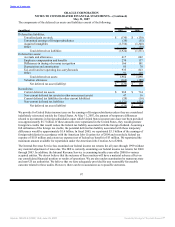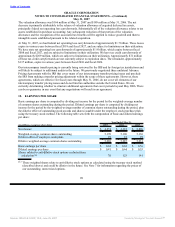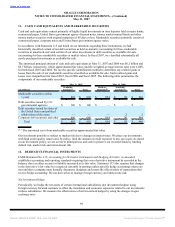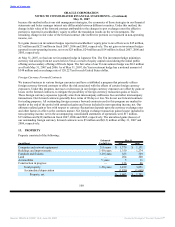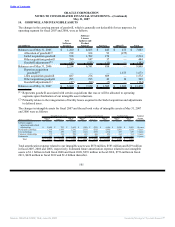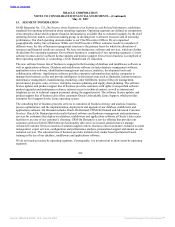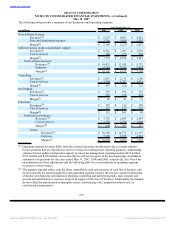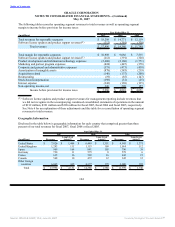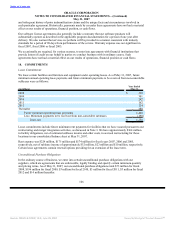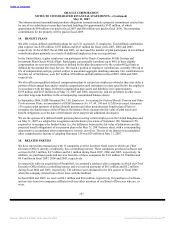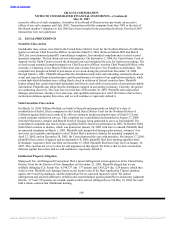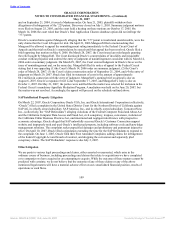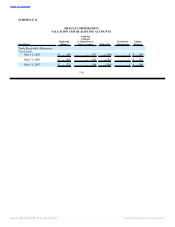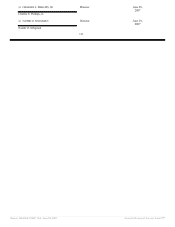Oracle 2006 Annual Report Download - page 112
Download and view the complete annual report
Please find page 112 of the 2006 Oracle annual report below. You can navigate through the pages in the report by either clicking on the pages listed below, or by using the keyword search tool below to find specific information within the annual report.
Table of Contents
ORACLE CORPORATION
NOTES TO CONSOLIDATED FINANCIAL STATEMENTS—(Continued)
May 31, 2007
(1) Long-lived assets excludes goodwill, intangible assets, equity investments and deferred taxes, which are
not allocated to specific geographic locations as it is impracticable to do so.
16. PEOPLESOFT CUSTOMER ASSURANCE PROGRAM
In June 2003, in response to our tender offer, PeopleSoft implemented what it referred to as the “customer
assurance program” or “CAP.” The CAP incorporated a provision in PeopleSoft’s standard licensing
arrangement that purports to contractually burden Oracle, as a result of our acquisition of PeopleSoft, with a
contingent obligation to make payments to PeopleSoft customers should we fail to take certain business
actions for a fixed period. The payment obligation, which typically expires four years from the date of the
contract, is fixed at an amount generally between two and five times the license and first year support fees
paid to PeopleSoft in the applicable license transaction. PeopleSoft customers retain rights to the licensed
products whether or not the CAP payments are triggered.
The maximum potential penalty under the CAP, by version, as of May 31, 2007 was as follows:
Maximum Potential
Dates Offered to Customers(1) Penalty
CAP Version Start Date End Date (in millions)
Version 1 June 2003 September 12, 2003 $ 75
Version 2 September 12, 2003 September 30, 2003 120
Version 3 September 30, 2003 November 7, 2003 40
Version 4 November 18, 2003 June 30, 2004 1,116
Version 5 June 16, 2004 December 28, 2004 743
Version 6 October 12, 2004 December 28, 2004 1,057
$ 3,151
(1) Some contracts originally submitted to customers prior to these end dates were executed following such
dates. The majority of the CAP provisions will expire no later than four years after the contract date.
This purported obligation was not reflected as a liability on PeopleSoft’s balance sheet as PeopleSoft
concluded that it could be triggered only following the consummation of an acquisition. We have concluded
that, as of the date of the acquisition, the penalty provisions under the CAP represented a contingent liability
of Oracle. The aggregate potential CAP obligation as of May 31, 2007 was $3.2 billion. Unless the CAP
provisions are removed from these licensing arrangements, we do not expect the aggregate potential CAP
obligation to decline substantially until fiscal year 2008 when these provisions begin to expire. We have not
recorded a liability related to the CAP, as we do not believe it is probable that our post-acquisition activities
related to the PeopleSoft and JD Edwards product lines will trigger an obligation to make any payment
pursuant to the CAP. While no assurance can be given as to the ultimate outcome of litigation, we believe we
would also have substantial defenses with respect to the legality and enforceability of the CAP contract
provisions in response to any claims seeking payment from us under the CAP terms.
17. GUARANTEES
Our software license agreements generally include certain provisions for indemnifying customers against
liabilities if our software products infringe a third party’s intellectual property rights. To date, we have not
incurred any material costs as a result of such indemnifications and have not accrued any liabilities related to
such obligations in our consolidated financial statements. Certain of our software license agreements also
include provisions indemnifying customers against liabilities in the event we breach confidentiality or service
level requirements. It is not possible to determine the maximum potential amount under these indemnification
agreements due to our limited
105
Source: ORACLE CORP, 10-K, June 29, 2007 Powered by Morningstar® Document Research℠



